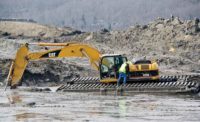EPA Eases More Environmental Rules As Nov. 3 Closes In

The U.S. Environmental Protection Agency issued two final rules easing key project anti-pollution compliance in the days leading up to the election. It says the changes offer needed industry flexibility, but environmentalists say they weaken protections and may violate the law.
EPA on Oct. 22 finalized the rollback of a long-standing clean air rule, New Source Review, which requires a construction permit and possible new pollution controls if an industrial or power plant project hikes facility emissions under a two-part analysis.
The final rule, which codifies 2018 agency guidance under former Administrator Scott Pruitt, streamlines the emissions review, which EPA says will aid the goal of revitalized industrial operations, its ninth change to New Source Review mandates during the Trump administration.
But the new rule “create a more lenient NSR regime and reduce EPA’s oversight … which could result in increased emissions,” said a Harvard University analysis. New York University’s nonpartisan Institute for Policy Integrity faulted EPA’s lack of any cost-benefit study.
In a final rule issued Oct. 16, coal plant operators can continue to store coal ash in existing unlined surface ponds and landfills if they demonstrate to EPA or state officials that impoundments have no negative effect on groundwater.
The rule now amends 2015 requirements set in the Obama administration to manage coal combustion residuals.
In the first of five anticipated changes to coal ash disposal rules, EPA in August said it reviewed engineering and construction data and found that not all utilities can meet a 2020 deadline to stop taking waste in unlined pits. It finalized changes to the storage regulations that gives utilities more time before they must stop receiving waste in unlined storage ponds and more time to close them.
EPA says the new rule increases utility flexibility in site specific cases, but environmentalists claim it weakens critical protections from toxic coal ash pollution and violates a 2018 order by the Washington, D.C., Court of Appeals to close coal ash ponds that lack specific types of liners.
The court had ordered EPA to strengthen, not weaken, the 2015 rule and to close unlined coal ash ponds, said Earthjustice, one group opposing the change. “The administration’s announcement opens the door to keeping some coal ponds open indefinitely that a court found should be closed to protect health, the environment and drinking water,” Lisa Evans, Earthjustice senior counsel, said in a statement.
Under the rule, unlined pits can remain open if a utility claims the soil beneath it is not porous and if certain chemicals are not polluting groundwater to a level above federal standards.
“Continued operation of these unlined or inadequately lined pits directly contradicts EPA’s 2014 risk assessment that found a high risk of arsenic contamination from pits without a plastic and clay (composite) liner,” the environmental group said. Recent data shows that 92% of the industry’s coal ash impoundments leak toxic contaminants such as arsenic, cobalt, lithium, molybdenum and radium, it said.
The Obama administration published the 2015 regulations seven years after an unlined surface impoundment at a Tennessee Valley Authority coal-fired plant ruptured and sent more than 1 billion gallons of coal ash suspended in water across 300 acres and into the Emory River. In 2014, a Duke Energy impoundment spilled 39,000 gallons of coal ash and 27,000 gallons of wastewater into the Dan River in North Carolina.
EPA is set to finalize another rollback that would drop an Obama administration requirement that coal plants set aside funds to clean up spills and pollution caused by coal ash. Earthjustice said the TVA spill cost more than $1 billion to clean up.
The agency on Oct. 14 asked for comments on another portion of the appellate court opinion, which remanded to EPA for reconsideration provisions of the 2015 rule that exempted inactive impoundments from the regulations.
The court said inactive surface impoundment ponds at inactive coal-fired plants are most likely to be unlined and unmonitored and are at risk of leaks and catastrophic structural failures. EPA is developing rules for such sites.
In other EPA actions, the agency agreed to crack down on smog caused by oil and fracked gas operations in eight states under a consent decree approved Oct. 21 by a federal court in San Francisco.
It must enforce federal Clean Air Act rules relating to ozone in Pennsylvania, New York, Connecticut, Virginia and in certain areas of Texas, Arizona and California, under the agreement with the Center for Biological Diversity.



